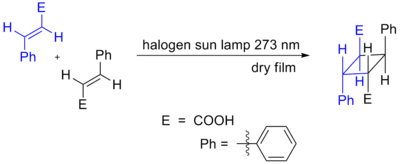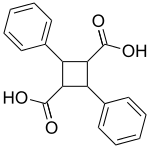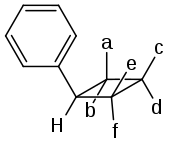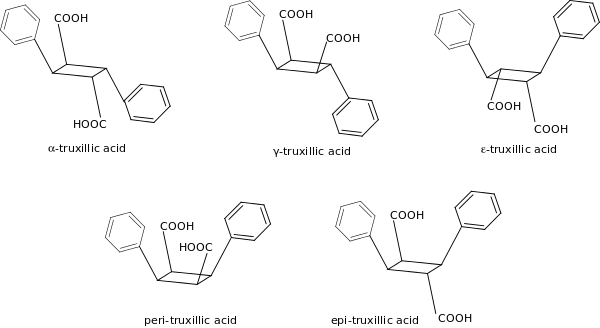Truxillic acid
Truxillic acids are any of several crystalline stereoisomeric cyclic dicarboxylic acids with the formula (C6H5)2C4H4(COOH)2. They are colorless solids. These compounds are obtained by the [2 + 2] photocycloadditions of cinnamic acid where the two trans alkenes react head-to-tail. The isolated stereoisomers are called truxillic acids.[1]
 Cinnamic Acid CycloAddition
Cinnamic Acid CycloAddition
 | |
| Names | |
|---|---|
| IUPAC name
2,4-Diphenyl-1,3-cyclobutanedicarboxylic acid | |
| Identifiers | |
3D model (JSmol) |
|
| ChemSpider | |
| ECHA InfoCard | 100.022.478 |
PubChem CID |
|
CompTox Dashboard (EPA) |
|
| |
| Properties | |
| C18H16O4 | |
| Molar mass | 296.322 g·mol−1 |
Except where otherwise noted, data are given for materials in their standard state (at 25 °C [77 °F], 100 kPa). | |
| Infobox references | |
Occurrence and reactions
These compounds are found in a variety of plants, for example in coca.[2][3] Incarvillateine, an alkaloid from the plant Incarvillea sinensis, is a derivative of α-truxillic acid.
Upon heating, truxillic acids undergo cracking to give cinnamic acid.[4]
Isomers
Truxillic acid can exist in five isomers.[5][6]

| Isomer | a | b | c | d | e | f |
|---|---|---|---|---|---|---|
| α-truxillic acid (cocaic acid[7]) | COOH | H | H | C6H5 | H | COOH |
| γ-truxillic acid | COOH | H | H | C6H5 | COOH | H |
| ε-truxillic acid | H | COOH | C6H5 | H | H | COOH |
| peri-truxillic acid | COOH | H | C6H5 | H | COOH | H |
| epi-truxillic acid | COOH | H | C6H5 | H | H | COOH |

See also
- Truxinic acids are isomers of the truxillic acids with phenyl groups on adjacent methyne centers.
References
- Cohen, M. D.; Schmidt, G. M. J.; Sonntag, F. I. (1964). "Topochemistry. II. The photochemistry of trans-cinnamic acids". J. Chem. Soc.: 2000–2013. doi:10.1039/jr9640002000.CS1 maint: uses authors parameter (link)
- Liebermann (1888). "Cinnamic acid polymers obtained from the minor alkaloids of cocaine" (PDF). Berichte der Deutschen Chemischen Gesellschaft. 21: 3372–3376. doi:10.1002/cber.188802102223.
- Krauze-Baranowska, Miroslawa (2002). "Truxillic and truxinic acids-occurrence in plant kingdom". Acta poliniae Pharmaceutica-Drug research. 59 (5): 403–410.
- Hein, Sara M. (2006). "An Exploration of a Photochemical Pericyclic Reaction Using NMR Data". Journal of Chemical Education. 83: 940–942. doi:10.1021/ed083p940.
- Stoermer (1924). "Five stereoisomers have been obtained: alfa-, gamma-, epsilon-, peri- and epi-isomers. Stereochemical configurations". Berichte der Deutschen Chemischen Gesellschaft, B: Abhandlungen. 57B: 15–23.
- Agarwai, O. P. (2011). Organic Chemistry Reactions and Reagents. Krishna Prakashan Media. ISBN 8187224657.
- "ChemSpider ID 10218892". ChemSpider. Retrieved 15 October 2016.
This article is issued from Wikipedia. The text is licensed under Creative Commons - Attribution - Sharealike. Additional terms may apply for the media files.